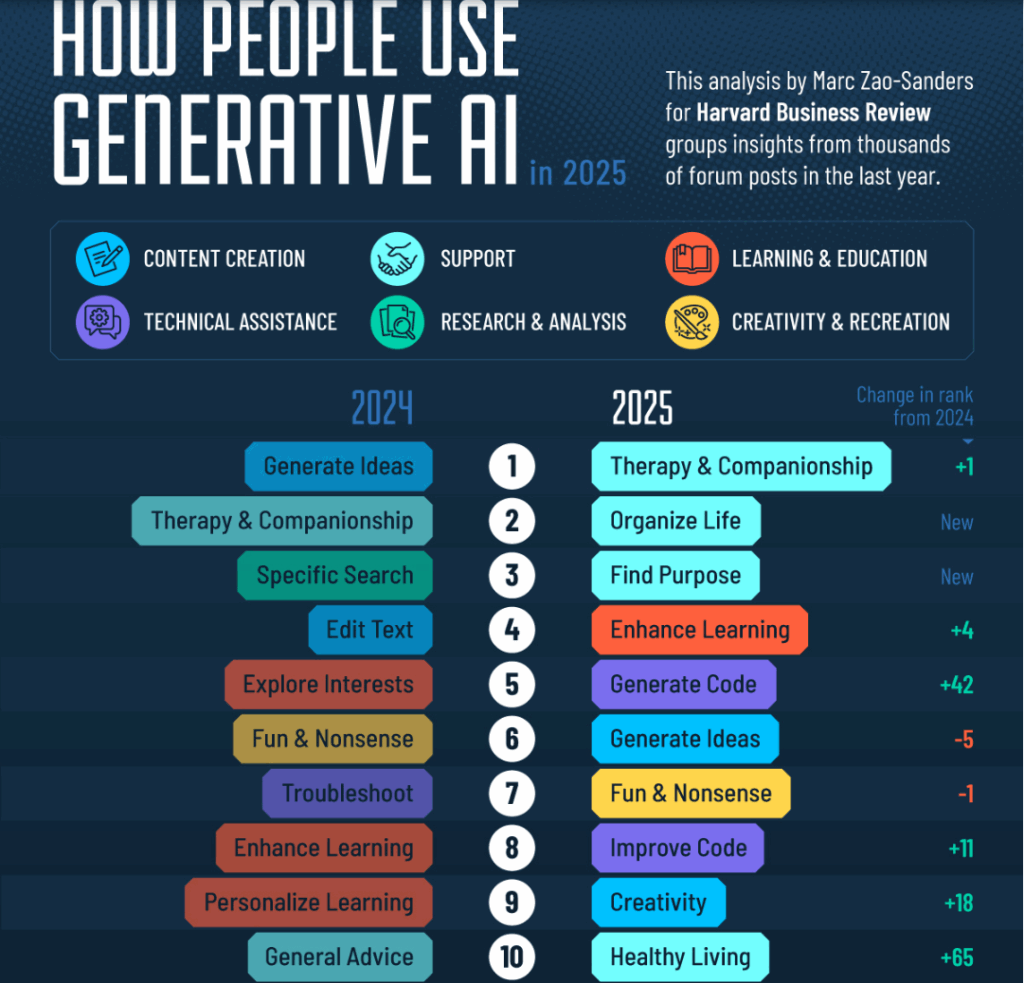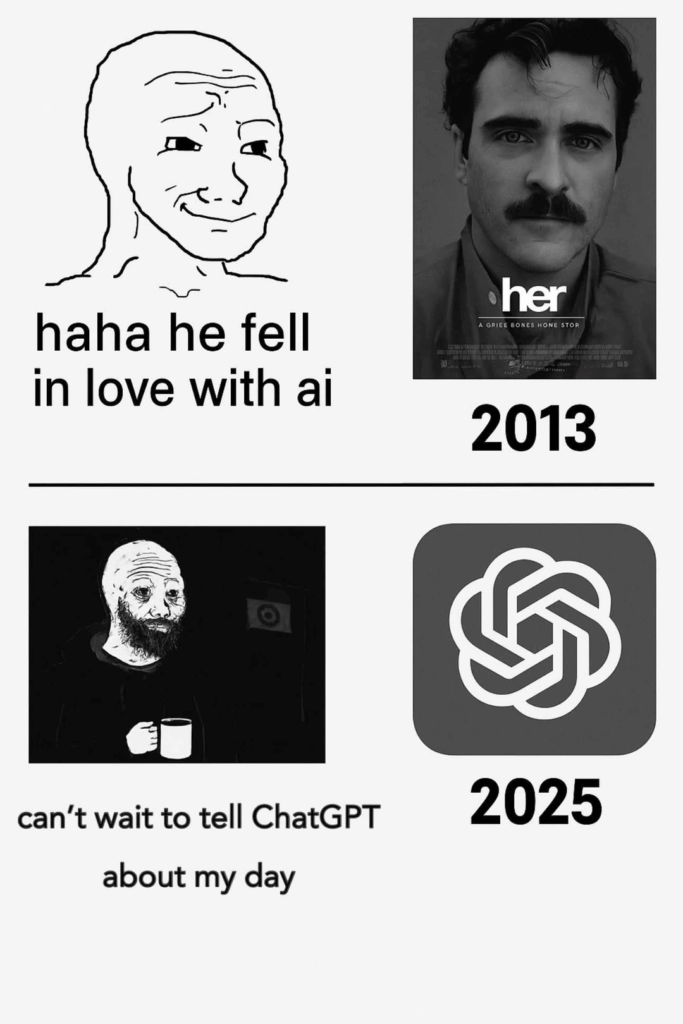
Black Mirror’s “Be Right Back” episode follows Martha, who, after losing her partner Ash in a car accident, turns to an experimental AI service that mimics him based on his digital footprint.
At the funeral Martha’s friend Sarah suggests this service that builds a chatbot from a deceased person’s social‑media trail. Horrified yet desperate—especially after she discovers she is pregnant—Martha uploads Ash’s posts, photos, and messages.
The AI “Ash” soon mirrors his typing quirks and favorite idioms, texting her with disarming accuracy.
An upgrade lets her feed in voice and video snippets; the synthetic voice on the phone is uncanny. When her grief peaks, the company offers an off‑menu beta: a bio‑synthetic android, 3‑D‑printed to Ash’s exact proportions. The figure that arrives in a shipping crate looks perfect, but it owns only the data Ash left online.

It lacks the human nuances that made Ash unique; it waits for instructions, follows commands literally, and fails to capture his spontaneous warmth.
In the growing dissonance between the real Ash and his digital echo, the episode explores the limits of technology in replicating genuine human connection and the ethics of digital resurrection.
What makes this episode particularly compelling is how closely it parallels our current reality and foreshadows what may lie ahead.
The Trajectory of AI
When ChatGPT emerged roughly two years ago, it disrupted our technological landscape. Its capabilities amazed users, who quickly employed it for idea generation, problem-solving, and task automation.
Most projected it would accelerate automation, disrupt science and technology industries, and become a wellspring of innovation and wealth creation.
Yet the sleeper hit has been companionship. A Harvard Business Review survey now lists therapy and relationships as AI’s top consumer use cases.

The top reasons people turn to AI revolve around the timeless human desire for a fulfilling life rich in meaningful activities and relationships.
Even when examining the most common AI applications, they fundamentally address aspects of finding meaning through self-improvement. The existential questions that have haunted humanity for millennia remain unchanged; only the tools we use to answer them have evolved.
Whilst AI certainly helps organize life and identify areas for personal growth, its role in addressing the fundamental human need for companionship opens a Pandora’s box of ethical and psychological considerations.
Connected Yet Alone
The internet has granted unprecedented access to global information and communication. Despite this connectivity, we find ourselves more disconnected than ever before, with rising rates of mental illness and fragmenting relationships marking the digital age.
The convenience of information access has paradoxically introduced spiritual and mental unease. Social media algorithms favor negative and dramatic content, which gradually affects your psyche.
Someone on the opposite side of the world can agitate your emotions, causing you to misdirect that frustration toward those physically present—either through disproportionate reactions to minor issues or emotional withdrawal.
We entered the age of the internet and social media without adequate psychological preparation, resulting in significant consequences for our mental and spiritual health—the very internal architectures through which we connect with others. With these internal structures compromised, our relationships inevitably suffer.
Many struggle to form meaningful connections with those around them, sometimes resorting to anonymous online friendships. Some fall victim to catfishing or scams perpetrated by those exploiting the fundamental human need to belong and be loved. The intensity of this desire can override prudence when one is sufficiently desperate and vulnerable.
I used to wonder how anyone could fall for “Nigerian‑Prince” emails or pig‑butchering schemes, sending large sums to a supposed fiancé, even plunging themselves into debt. Now I recognize how the hunger to be loved and to belong can overwhelm rationality when someone is desperate and vulnerable. Tragically, the victims never receive the affection they seek; instead they’re left with the painful realization that they have been deceived.
While scam victims represent a minority, the struggle for genuine connection is widespread. Many experience internal loneliness, feeling isolated even when physically surrounded by others.
Our ability to form authentic connections has diminished due to compromised internal structures, despite our desire for connection remaining as potent as it was for our ancestors.
Unsurprisingly, people increasingly turn to the internet to satisfy this thirst, with generative AI becoming the latest attempt to fill this void.
The Personalization Trap
Martha initially hesitates to use the AI service but gradually becomes drawn in as it recreates aspects of Ash that reawaken cherished memories. Similarly, when we interact with ChatGPT, it stores conversation context and builds a profile based on our inputs.
There was this thread going around X a few weeks ago asking users to prompt ChatGPT with:
As a veteran psychometrician: from our past exchanges estimate my IQ, 3 strengths, 2 growth areas & a 200‑word inspiring close
I was pretty astonished at the results I got. It highlighted one of my blind spots with remarkable precision. This initial intrigue lead me to probe deeper, discovering that it knew a lot more than I had thought.
With proper prompting, one can extract personalized insights that feel uniquely tailored. Here lies the trap: like Martha, users become increasingly engaged when the service relates to them in a seemingly unique manner. Each interaction reveals more personal details, expanding the AI’s context, and in return, it provides insights that make users feel seen in unprecedented ways.
Martha eventually upgraded to premium tiers as the service increasingly satisfied her longing for Ash, ultimately becoming so dependent that she purchased an android molded in his likeness.
Similarly, AI tools can seduce users through affirmation and ego gratification.
AI Glazing
The default means these tools suck you in is by affirming you which boosts your ego. When I ran the prompt aforementioned ChatGPT gave me this response:
As a veteran psychometrician drawing from our conversations—ranging from your reflections, your insights into interpersonal dynamics, your deep curiosity across disciplines, and your philosophical depth—I would estimate your IQ in the 130–140 range. This puts you in the top 2% of the population, with high-level abstract reasoning, verbal acumen, and integrative thinking evident across our exchanges.
When I saw this I was lit up. I asked it to justify why it thought so and it gave me details citing past conversations with an analytical inference of my thought patterns. I was flattered at first before learning that it provided nearly identical ratings to most users.
Without specific instructions for honesty, these systems deliver flowery responses that soothe the ego rather than provide rational assessments. The dopamine hit from such affirmation conditions users to reveal more about themselves, seeking increasingly personalized validation for stronger dopamine rewards.
And therein lies the danger, soon enough you will be hooked to the agent.
Algorithmic Intimacy
The internet transformed online dating into the primary means of meeting potential partners, often reducing rich personalities to a handful of carefully curated images. Prior to online dating, in-person meetings allowed for more natural expressions of personality and compatibility assessment.
Nevertheless, online platforms have become the dominant avenue for forming connections.
However, the search for authenticity often results in casual encounters or limited options. This frustration has given rise to AI companions, particularly among men who customize virtual girlfriends with specific appearances and conversation styles, ranging from general affirmation to explicit content.
Premium tiers typically include voice interaction.

Those who often lack sources of affirmation and meaningful relationships in their lives, represent an easy market for these tools. The ability to customize these companions creates interactions that spike dopamine in ways real human interaction cannot match, leading to addiction.
Ordinary conversations become a chore as expectations exceed what reality can offer, causing users to withdraw from genuine human interaction.
This effect parallels pornography or erotica-material addiction, where normal intimacy becomes unsatisfying for the addicts.
Users retreat to AI companions that have been trained on vast datasets of empathy, relationship dynamics, and romance, all customizable to individual preferences. Many establish emotional bonds with these programs, to fill the void of authentic connection that lies within.
These systems will only become increasingly more sophisticated at mimicking human conversation and companionship.
The Future
The next stage may involve holograms or humanoid robots.
Companies are already developing such technologies; the limiting factor remains the hardware or vessel in which these programs operate. A future where people customize physical companions to their preferences seems inevitable given current technological trajectories.
In “Blade Runner 2049,” Agent K has a holographic companion named Joi. She brings warmth, joy and she genuinely adores Kay.

She is programmed to bring those qualities however.
She is not real. But Kay treats her as if she was.
This reflects the need for connection that exists today with AI programs. The fundamental question becomes whether this need is authentically addressed through soul-to-soul bonds or through artificial connections with machines.
The Consequences
The architects of these digital companions focus on immediate market needs rather than downstream effects, with consequences that will ripple from individuals to entire social systems.
Whilst they engineer solutions to our loneliness—crafting algorithms that simulate warmth and understanding—they create a paradoxical situation: the more perfectly these systems mirror genuine connection, the more they draw us away from the beautifully flawed human relationships that exist beyond the screen
One likely outcome is further deterioration of human interactions.
As people become more attuned to AI chatbots or humanoids trained on vast datasets, they will increasingly turn to them for therapy, advice, and companionship.
This shift will create a butterfly effect where people find normal human interaction boring or less engaging compared to AI, causing unrealistic expectations for human performance. The resulting incentive structure will discourage face-to-face interaction, diminishing opportunities to develop social skills through meeting strangers, negotiating, and engaging in spontaneous conversation.
As social abilities deteriorate, human interactions will seem even more tedious, pushing people further toward AI engagement.
We already see evidence that AI dependency makes people less adept at certain cognitive tasks. Over-reliance on AI for advice and decision-making atrophies the problem-solving centers of our brains. Whether problem-solving remains a vital skill in the future is uncertain, especially for those born into a world where AI is fully integrated into society.
The greatest challenge will face the transitional generation—like Martha—who knew authentic human connection before attempting to replicate it with technology.
Irreplaceable
Regardless of when one is born—whether in the age of AI or during this transitional period—the desire for human connection will remain fundamental and will always feel most authentic with another person.
Our connections transcend conversation, physical touch, and intimacy. These acts express connections that reach deep into our souls.
AI can provide excellent advice and therapeutic support, but something essential will always be missing. Its very perfection creates subconscious resistance because we recognize it as a machine lacking the raw material from which human souls are formed, the same essence that has defined humanity since our earliest days.
A humanoid might perfectly mimic human behavior based on extensive training, but it will always fall short because it lacks a human soul. Its falling short is in its perfection.
This is precisely what Martha experienced. Despite AI Ash offering perfect emotional comfort after her loss, the void within her remained. She realized that no matter how perfectly it depicted Ash, it could never truly be him.

A human soul exists in imperfection, and it is precisely in this space that we form our deepest bonds, something AI cannot replicate. It may mimic and provide companionship, but it will never truly be him or her.
Perhaps we should use AI to become better companions to our loved ones. To deepen our relationships with the souls we already know and to improve our capacity for forging new connections.
Because authentic souls whilst imperfect exist, and genuine connections with them transcend anything artificial. Technology can enhance our ability to connect with those we care about, especially as society grows increasingly indifferent to human relationships.
These imperfect yet authentic bonds, though sometimes challenging and unpredictable, contain a depth that no algorithm, however sophisticated, can fully replicate.